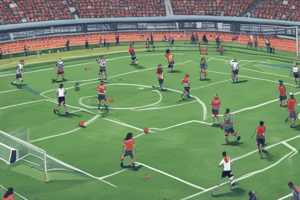Podcast
Questions and Answers
What is the primary responsibility of a Goalkeeper?
What is the primary responsibility of a Goalkeeper?
- To create scoring opportunities
- To prevent the opposing team from scoring (correct)
- To support both defense and attack
- To distribute the ball to other players
What is the role of a Central Midfielder?
What is the role of a Central Midfielder?
- To break up opposition attacks and distribute the ball
- To defend the goal and win headers
- To support both defense and attack, creating scoring opportunities (correct)
- To create scoring chances with passes and shots
What is the characteristic of a 4-4-2 formation?
What is the characteristic of a 4-4-2 formation?
- It is a traditional and defensive formation (correct)
- It is a more attacking formation
- It is a balanced formation
- It is a formation that focuses on counter-attacking
What is the goal of Possession football?
What is the goal of Possession football?
What is the role of a Winger?
What is the role of a Winger?
What is the characteristic of a Counter-attacking playing style?
What is the characteristic of a Counter-attacking playing style?
Flashcards
Goalkeeper's primary responsibility
Goalkeeper's primary responsibility
The main goal of the goalkeeper is to prevent the other team from scoring by stopping shots and protecting the goal.
Central Midfielder's role
Central Midfielder's role
Central midfielders are responsible for both defending their own goal and attacking the opposing team's goal, they control the flow of the game in the middle of the pitch.
Characteristics of 4-4-2 formation
Characteristics of 4-4-2 formation
The 4-4-2 formation is known for its strong defensive structure with four defenders and four midfielders, making it a classic and often defensive strategy.
Goal of Possession football
Goal of Possession football
Signup and view all the flashcards
Role of a Winger
Role of a Winger
Signup and view all the flashcards
Characteristics of Counter-attacking
Characteristics of Counter-attacking
Signup and view all the flashcards
Study Notes
Player Positions
- Goalkeeper (GK): Responsible for preventing the opposing team from scoring by defending the goal.
- Defenders (DF):
- Centre-back (CB): Defends the goal and wins headers.
- Full-back (FB): Supports both defense and attack, often making runs down the flank.
- Midfielders (MF):
- Defensive midfielder (DM): Breaks up opposition attacks and distributes the ball.
- Central midfielder (CM): Supports both defense and attack, creating scoring opportunities.
- Attacking midfielder (AM): Creates scoring chances with passes and shots.
- Winger (WG): Uses speed and dribbling skills to attack the opponent's defense.
- Forwards (FW):
- Striker (ST): Scores goals and holds up the ball.
- Secondary striker (SS): Supports the main striker and creates scoring opportunities.
Tactics
- Formations:
- 4-4-2: Four defenders, four midfielders, and two forwards. A traditional and defensive formation.
- 4-3-3: Four defenders, three midfielders, and three forwards. A more attacking formation.
- 4-2-3-1: Four defenders, two holding midfielders, three attacking midfielders, and a lone striker. A balanced formation.
- Playing Styles:
- Possession football: Maintaining possession to tire the opponent and create scoring opportunities.
- Counter-attacking: Quickly transitioning from defense to offense after gaining possession.
- Long ball: Kicking the ball long to a target man or winger to bypass the opponent's press.
- Defensive Strategies:
- Parking the bus: Defending deeply and compactly to prevent scoring opportunities.
- Pressing: Applying pressure to the opponent immediately after losing possession.
- Marking: Assigning a defender to tightly mark an opponent's key player.
Studying That Suits You
Use AI to generate personalized quizzes and flashcards to suit your learning preferences.




